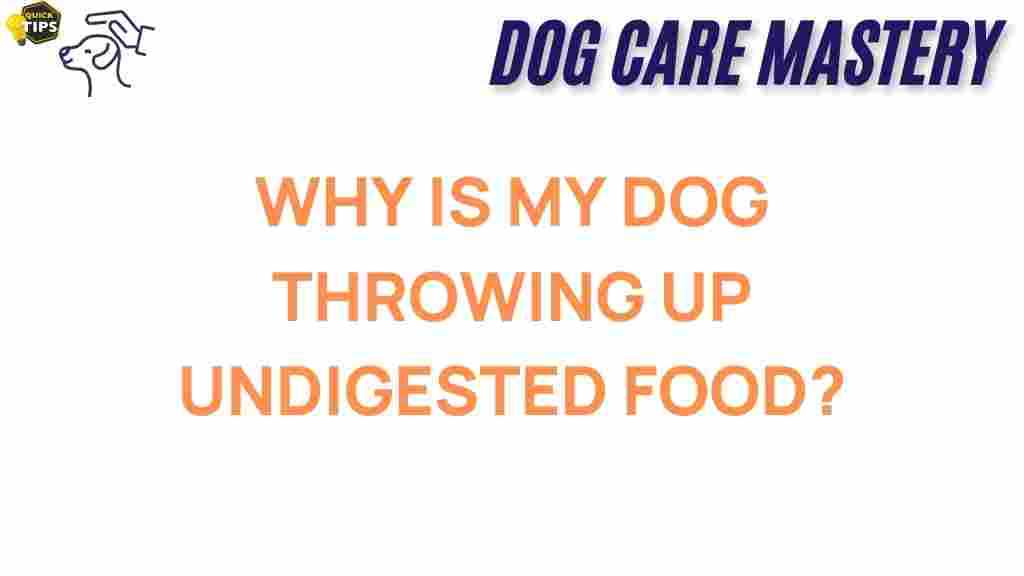Dog Vomiting: Unraveling the Mystery Behind Undigested Food
As a devoted dog owner, witnessing your beloved pet throw up can be a distressing experience. While occasional dog vomiting may not be cause for alarm, when it’s accompanied by undigested food, it raises several questions. Understanding the reasons behind this phenomenon is essential for your dog’s health and well-being. In this article, we will explore the potential causes, symptoms, and solutions to help you manage your dog’s vomiting effectively.
Understanding Dog Vomiting
Dog vomiting is a common issue that can stem from various factors. To differentiate between normal and concerning instances of vomiting, it’s crucial to identify the characteristics of the vomit, the frequency of occurrence, and accompanying symptoms. Here are some key points to consider:
- Frequency: Is it a one-time occurrence or a recurring issue?
- Appearance: Is the vomit food, liquid, or bile? Is it undigested?
- Behavior: Is your dog acting normally or does it seem lethargic or distressed?
- Additional Symptoms: Are there other signs such as diarrhea, lethargy, or decreased appetite?
Why Is My Dog Throwing Up Undigested Food?
When your dog vomits undigested food, it can indicate a few underlying issues. Here are some common causes:
1. Eating Habits
Dogs often eat their meals quickly, especially if they’re anxious or excited. This behavior can lead to:
- Air ingestion: Dogs may swallow air along with their food, causing discomfort and vomiting.
- Overeating: Consuming too much food at once can overwhelm their digestive system.
2. Food Quality and Type
The type and quality of food can significantly impact your dog’s digestive health. Consider the following:
- Low-quality ingredients: Some dog foods contain fillers and artificial additives that can upset your dog’s stomach.
- Food intolerances: Your dog may be sensitive or allergic to certain ingredients, leading to gastrointestinal issues.
3. Health Conditions
Underlying health issues can also lead to dog vomiting. Some possible conditions include:
- Gastrointestinal disorders: Conditions like gastritis or inflammatory bowel disease can disrupt normal digestion.
- Infections: Bacterial or viral infections can lead to vomiting and other gastrointestinal symptoms.
- Parasites: Intestinal worms or other parasites can cause significant digestive distress.
4. Stress and Anxiety
Just like humans, dogs can experience stress and anxiety, leading to vomiting. Situations such as:
- Moving to a new home
- Traveling
- Changes in routine
can trigger gastrointestinal upset.
Step-by-Step: What to Do When Your Dog Vomits Undigested Food
When faced with a situation of dog vomiting, it’s crucial to act systematically. Here’s a step-by-step guide to help you manage the situation:
Step 1: Assess the Situation
Observe your dog closely. Take note of:
- The frequency of vomiting
- The appearance of the vomit
- Any accompanying symptoms like diarrhea or lethargy
Step 2: Monitor Your Dog’s Behavior
Is your dog acting normally? Look for changes in behavior such as:
- Lethargy
- Loss of appetite
- Excessive drooling
Step 3: Check the Diet
Evaluate what your dog has been eating. Consider:
- The type of food
- The feeding schedule
- Recent changes in diet
Step 4: Hydration
Ensure your dog stays hydrated, especially if vomiting persists. Offer small amounts of water frequently, and monitor for any signs of dehydration.
Step 5: When to Consult a Veterinarian
If your dog continues to vomit undigested food, or if you notice any alarming symptoms, it’s essential to seek veterinary care. Signs that warrant immediate attention include:
- Repeated vomiting
- Bloody vomit
- Severe lethargy
- Persistent diarrhea
For more information on when to visit the vet, check out this helpful resource.
Troubleshooting Tips for Dog Vomiting
While seeking veterinary care is crucial when necessary, you can also implement some strategies at home to alleviate your dog’s vomiting. Here are a few troubleshooting tips:
1. Change Feeding Habits
Encourage slow eating by:
- Using slow feeder bowls
- Dividing meals into smaller portions
- Feeding your dog in a quiet, stress-free environment
2. Evaluate and Adjust Diet
Consider switching to a high-quality dog food that’s appropriate for your dog’s age, size, and health needs. Look for:
- Natural ingredients
- Limited ingredient diets if food sensitivities are suspected
- Consultation with your vet for dietary recommendations
3. Reduce Stress
To minimize stress-related vomiting, create a calm environment. Some ideas include:
- Establishing a consistent routine
- Providing a safe space for your pet
- Using calming products or supplements if necessary
Conclusion
Dog vomiting, particularly when it involves undigested food, can be alarming for pet owners. Understanding the potential causes and implementing appropriate strategies can make a significant difference in managing your dog’s health. Always remain vigilant about your dog’s behavior and seek veterinary assistance when necessary. With the right care and attention, you can help your furry friend overcome this troubling issue.
For more tips on dog health and wellness, check out our comprehensive guide on maintaining your dog’s overall well-being.
This article is in the category Health and created by dogcaremastery Team
